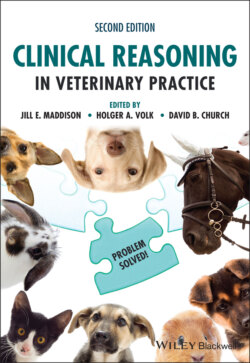Читать книгу Clinical Reasoning in Veterinary Practice - Группа авторов - Страница 71
Diagnostic approach to the patient reported to be vomiting
ОглавлениеIt is imperative to carefully evaluate the history and physical examination findings for any clues that indicate whether the patient is vomiting or regurgitating and may suggest secondary or primary GI disease. You cannot always determine from the history and physical examination whether primary or secondary GI disease is most likely, but it is important that you ask yourself these questions: Is this patient vomiting or regurgitating? and Does this patient have primary or secondary GI disease or I can’t tell?, as this will assist in directing your history taking and physical examination as you search for clues to enable you to answer these key questions.
In some vomiting cases, it will be obvious that primary GI disease is most probable (e.g. the bright, happy dog that, for several days, has been vomiting consistently half an hour after eating and has no other systemic signs). Or it may be clear that secondary GI disease is most likely (e.g. the cat that has been intermittently vomiting for a week, inappetant for 4 weeks and is also polydipsic). However, often, you cannot be sure based on the history and physical, so your diagnostic procedures will be aimed initially at answering the question, What system is involved and how? You won’t always be able to answer the question initially, but it is essential that you ask it.
If indicated by the history and/or physical examination, investigate secondary GI disease with appropriate diagnostic tools such as biochemistry, haematology and urinalysis. Only a proportion of vomiting animals will require a diagnostic work‐up, but it is still important to consider whether primary or secondary GI disease is likely, as this will influence your symptomatic treatment.
As discussed earlier, the most common causes of primary GI disease, such as gastritis due to dietary indiscretion, will usually respond satisfactorily to symptomatic treatment (which should rarely, if ever, include antibiotics). However, most secondary GI disease will not, and further information is required for management and prognosis.
